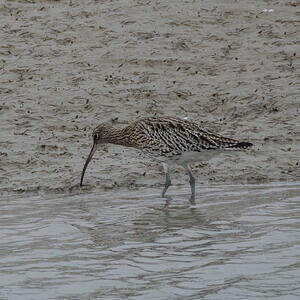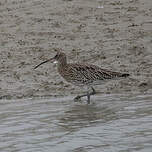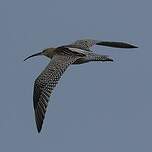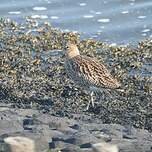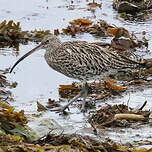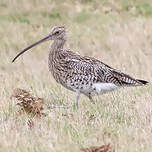Eurasian Curlew
Numenius arquata - Courlis cendré
Identification
Eurasian Curlews are large shorebirds with a downcurved bill. With a length of over 50 cm, a wingspan of around one meter, and a weight that can exceed one kilo, the Eurasian Curlew is the largest of its kind. Its curved beak, which has given it its specific name arquata, measures 10 to 15 cm. That of the male (10 to 12.4 cm) is shorter than that of the female (13 to 15.2 cm), which constitutes sexual dimorphism, allowing the sex of the birds to be recognized in the field. In addition, with identical plumage, the male is slightly smaller than the female. However, it is difficult to sex an isolated bird without a comparison point; this requires some practice. From a distance, the bird appears brown, with a lighter underside. Up close, the complexity of the plumage can be seen. The upper parts are covered with brown feathers with, depending on their location, edgings, bars, indentations or russet-colored stripes. The head, neck and chest are russet-colored, striped with brown. The throat is white. There is a slight effect of a skullcap due to the upper part of the head being a little darker. The dark eye is circled with white. The beak is brown with the base of the lower jaw pink. The white flanks show brown designs shaped like an anchor. The belly is white. The tail is clearly barred. In a flying bird, the white of the rump that rises in a point on the back is well seen because it contrasts with the brown of the top. From below, the wings are pale and flecked with light brown. The gray legs protrude slightly beyond the tail. Birds of the orientalis subspecies are generally paler, with a less marked underside of dark, in particular the wings. The juvenile is more yellowish, with less marked flanks, and its beak is shorter.
Subspecific information 3 subspecies
- Numenius arquata arquata (w, n and c Europe)
- Numenius arquata suschkini (w Kazakhstan to sw Siberia)
- Numenius arquata orientalis (w and c Siberia to Manchuria)
Foreign names
- Courlis cendré,
- Zarapito real,
- maçarico-real,
- Brachvogel,
- nagy póling,
- Wulp,
- Chiurlo maggiore,
- storspov,
- Storspove,
- hvizdák veľký,
- koliha velká,
- Storspove,
- kuovi,
- Europese Wulp (Grootwulp),
- becut eurasiàtic,
- Fjöruspói,
- kulik wielki,
- kuitala,
- veliki škurh,
- Большой кроншнеп,
- Gajahan besar,
- ダイシャクシギ,
- 白腰杓鹬,
- นกอีก๋อยใหญ่,
- 大杓鷸〔白腰杓鷸〕,
Voice song and call
The name Courlis comes from the usual cry of the species, a bisyllabic coouu hi sound which is both a contact and a warning cry. One of the strong distress cries, a prolonged wa wa wa wa wa, is reminiscent of one of the Curlieu's cries, which is heard from migrating birds for example, although with a lower and less musical tone. The strong alarm cry is a quick succession of powerful high-pitched notes tchi wi wi wi wi wi uh. Other cries are untranslatable. The song, emitted during the parade flight, is loud and spectacular. It starts with a long, powerful succession of coui and then moves on to a sequence of rolled notes which can end with a trill at the end of the emission.
Habitat
The Eurasian Curlew is a bird of very open and often wet environments. It breeds in fairly diverse habitats that have in common an open view, deep and soft soil and a great variety of vegetation.
Behaviour character trait
The Eurasian Curlew is a wild bird that is wary of humans. It is always on guard and, at the slightest alarm, takes flight. But an observant and careful watcher can spot this large bird walking across the meadows with determination, punctuated by pauses during which it probes the wet ground with its long, curved and sensitive beak. It is a gregarious bird outside of the breeding season. It forms groups that can be large during migration, especially in the resting places, or in the wintering grounds. On the other hand, during the breeding season, couples are territorial and divide up the favourable lands, keeping their distance.
The return to wintering grounds occurs from February to May, depending on the latitude. In France, the first adults arrive on the breeding grounds at the end of February, but the breeding itself, which is more delayed, starts in April. In the meantime, the favourable meadows come alive with their courtship flights and their very demonstrative song. Later, during the nesting phase, they are often seen chasing raptors and other large birds flying over the territory, which they consider potential dangers. At this point, it is best to avoid disturbing the meadows ourselves, or else the eggs may end up in the stomach of a crow, always on the lookout for easy prey. In case of breeding failure, the adults quickly leave the area and do not return. On the other hand, if the nesting is successful, the adults become very sensitive and react vigorously to anything that might threaten the young. Shortly after the young can fly, the families leave the area until the following year. From this point, the gregariousness takes over, in particular in the formation of nocturnal dormitories that can group hundreds of curlews in specific sites, including artificial sites such as industrial ponds in Lorraine, of course in order to protect them from land predators.Flight
Dietfeeding habits
The Eurasian Curlew feeds mainly on invertebrates caught from the ground or the substrate as long as its beak can get in.
The prey consists of annelids, molluscs, arthropods and occasionally small vertebrates. It uses its long beak with its sensory cells to probe soft or wet soils, mud and other habitats rich in living organisms. It also feeds on berries and seeds, cereals for example. In the prairies where it nests, the Eurasian Curlew mainly consumes insects and earthworms. On its wintering areas in the sea, it preys on available resources such as polychaete worms, small crabs and molluscs. It has been proven that the diet varied according to the sex due to the beak length, shorter for males. The males tend to prefer crabs while females look more for bivalve molluscs, dig deeper in the substrate.Reproduction nesting
The breeding period of the Eurasian Curlew begins with courtship displays to form and consolidate territorial couples. The male emits its loud song during the nuptial flight. This flight includes a rapid and steep ascent with strong vigorous wingbeats and continues with a long gliding descent during which the song ends in trilles. On the ground, the male follows the female who evades him, the taming ritual can last for days until the female is receptive and agrees to couple. The nest site is likely chosen by the female who tryouts multiple places by turning around and flattening herself on the ground while the male watches.
The chosen spot is usually a slightly higher part of the territory, sheltered from sudden flooding and from where the brooder can have an unobstructed view in all directions. The nest is simply built from some dry grass placed directly on the ground. The female lays an average of 4 eggs (3 to 5), dark olive brown, speckled with darker brown which she incubates, occasionally relieved by the male, for 27- 29 days. The nest is reputedly untraceable due to the homochrome hue of the eggs. As with all precocial species, hatching is almost simultaneous, which allows the chicks to leave the nest together. The chicks feed themselves after only a few days but they will only take off after 32-38 days. In the Nordic countries, raising the chicks is mainly the responsibility of the male, which allows the female to leave earlier to nurse her health. In France, the female takes care of nearly all the incubation and generally does not leave her chicks until they are almost flightworthy. The male, on the other hand, is mainly in charge of their protection during this entire period.Geographic range
The Eurasian Curlew is an Eurasian species whose breeding range extends from temperate latitudes in the British Isles to the Amur region in the Far East, reaching as far as Scandinavia in the north, France and Ukraine in the south, and northern Mongolia. The eastern subspecies, orientalis, is found in the eastern part of the range from Central Siberia onward. Its winter range is disjunct, except in western Europe where it is occasionally seen around the North Sea, English Channel, and the Atlantic coast. It is also found along southern coastal areas, the Mediterranean, all coasts of Africa, the Arabian peninsula, as well as South and Southeast Asia (from Korea in the north to Indonesia in the south), but not Australia. It also visits large inland floodplains and wetlands in Africa and southern Eurasia such as the Niger Basin, Indus Basin, etc.
Threats - protection
IUCN conservation status
concern
in the Wild
threatened
evaluated
Until recently, the species was considered to be non-threatened. However, recently it has been put into the category of vulnerable species due to several negative factors impacting its demography. Its global status is "near threatened". In Great Britain, after a 48% fall in its populations in the last 20 years, the Eurasian Curlew has recently been added to the national red list. It is talked about granting it absolute priority in terms of conservation actions. Taking the example of France, its breeding population has been classified as "vulnerable" (the status probably isn't accurate enough because reliable updates of the breeding populations - and therefore of trends - have not been available for many years, so old numbers have been taken into consideration for the analysis). Meanwhile, its wintering population is considered to be non-threatened. It is due to losses in habitats due to changes in land occupation and management. The Eurasian Curlew was doing well, adapting to large-scale cut-meadows, but unfortunately, the agriculture has modernized and mechanized for economic return; modern practices, such as ensilage and wrapping, threaten the species' subsistence in the long-term. In its traditional breeding areas, the Eurasian Curlew is the victim of the following: - The turning-over of meadows to crops, which has caused its disappearance from Alsace, as the wide tracts of land were transformed into maize fields - The draining of meadows which dry them out - Rolling the meadows in the spring to eliminate the molehills and other rough parts, which can end up destroying early incubations - The input of fertilizers, that stimulates the growth of meadow coverage (which become too high and dense for the breeding of nests), and also dwindles the valuable vegetation diversity essential to the curlew.Furthermore, the fertilization of the plots is a source of numerous disturbances, sometimes prohibitive if the laying had already taken place - of the mowing of the meadows, correlative to the ongoing climate changes, which makes naught the Eurasian Curlew nesting. The practice of ensilage or roll-wrapping allows to store the product of mowing in April-May and is particularly harmful. To counter these negative effects, agri-environmental measures have been in place for a number of years, allowing for the adaptation of agricultural management to the major nesting areas of the Eurasian Curlew (and the Water Rail, a victim like the curlew). In exchange for financial compensation, voluntary farmers accept to mow their plots later to allow the nests to take off. There is also the problem of hunting. Following a moratorium of up to 2018, the species is spared on the nesting sites, but not on the migration routes or in winter (it can be hunted on the Public Maritime Domain in France). However, due to the negative evolution of its status, hunting should be prohibited at all times and everywhere.
Sources of information
- IOC World Bird List (v15.1), Gill, F and D Donsker (Eds). 2025-12-07.
- Shorebirds, an identification guide to the waders of the world, Peter Hayman, John Marchant Tony Prater
- Limicoles, gangas et pigeons d'Europe, Paul Géroudet (mise à jour Georges Olioso)
- HBW Alive,
- Avibase, Lepage Denis
- xeno-canto, Sharing bird sounds from around the world,
Other sources of interest
 Specification sheet created on
20/07/2023 by Jean François
Specification sheet created on
20/07/2023 by Jean FrançoisTranslation by AI Oiseaux.net
© 1996-2025 Oiseaux.net
- Accipitriformes
- Aegotheliformes
- Anseriformes
- Apodiformes
- Apterygiformes
- Bucerotiformes
- Caprimulgiformes
- Cariamiformes
- Casuariiformes
- Charadriiformes
- Ciconiiformes
- Coliiformes
- Columbiformes
- Coraciiformes
- Cuculiformes
- Eurypygiformes
- Falconiformes
- Galliformes
- Gaviiformes
- Gruiformes
- Leptosomiformes
- Mesitornithiformes
- Musophagiformes
- Nyctibiiformes
- Opisthocomiformes
- Otidiformes
- Passeriformes
- Pelecaniformes
- Phaethontiformes
- Phoenicopteriformes
- Piciformes
- Podargiformes
- Podicipediformes
- Procellariiformes
- Psittaciformes
- Pterocliformes
- Rheiformes
- Sphenisciformes
- Steatornithiformes
- Strigiformes
- Struthioniformes
- Suliformes
- Tinamiformes
- Trogoniformes








